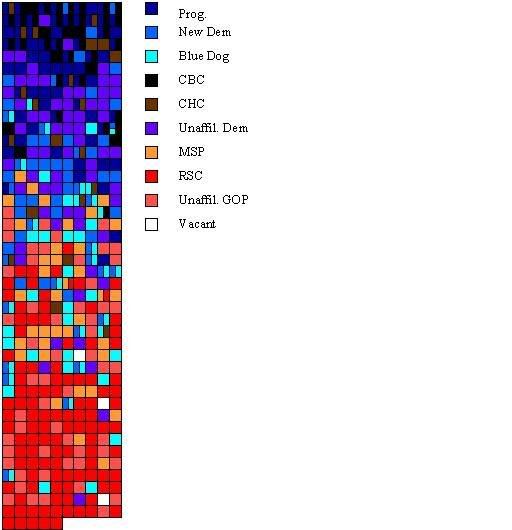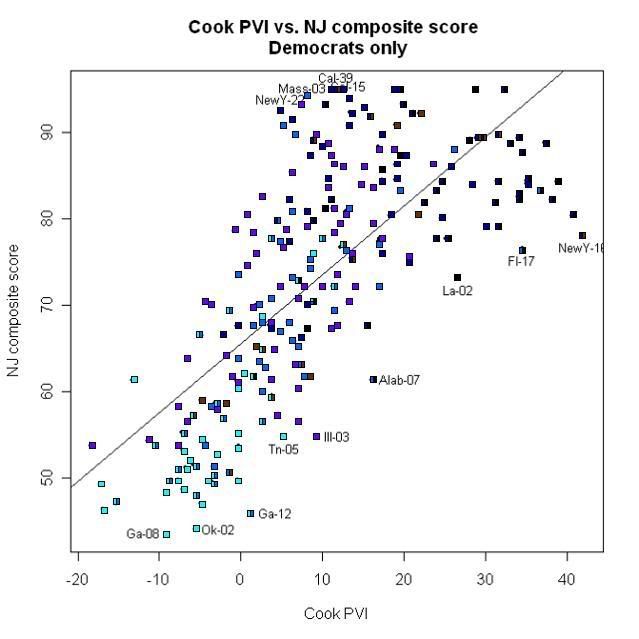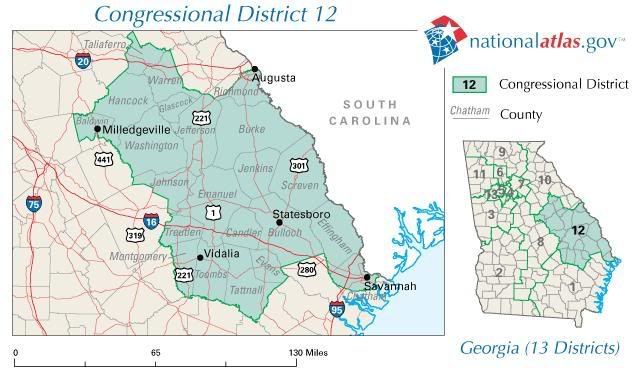(Excellent work. From the diaries – promoted by James L.)
You may recall I did a few diaries last month where I explored the relationship between representatives’ voting records and the lean of their districts (see here and here). One other question I had wanted to work into my discussion was the role of the various ideological Congressional caucuses.
There are pretty clear differences between the voting records of members of the different caucuses, but does membership in particular caucuses correlate with a particular kind of district? And is any particular caucus generally ‘out-of-whack,’ where the members as a whole tend to overperform or underperform their districts? In particular, I was wondering about the Blue Dogs, who tend to get the lion’s share of the abuse from the left blogosphere. It’s well understood they’re the most conservative members of the House Democrats… but are they also the most underperforming?
For those who aren’t familiar with the caucuses, there are three major ideological caucuses for the House Democrats: the Progressive Caucus, which comprises many of the House’s most liberal members (and, generally, those from the most urban districts), the New Democrat Coalition, which, although it’s a lineal descendent of the Democratic Leadership Council, tends to represent the ideological midpoint of the Democratic caucus, and the Blue Dog Coalition, representing the most conservative Democratic House members (and, not coincidentally, most of the ones from the most rural districts). Also within the Democratic party are the Congressional Black Caucus, which has significant overlap with the Progressive Caucus, and the Congressional Hispanic Caucus, which tends to range across the Democratic spectrum. Likewise, although it receives less attention, there is a similar schism on the Republican side, between the Main Street Partnership, comprised generally of more moderate representatives in suburban districts, and the more conservative Republican Study Committee.
Here’s an instance where a picture is worth a thousand words: this chart has a box for each representative (grouped in rows of 10), arranged from most liberal voting record at top to most conservative at bottom, color-coded according to caucus membership. (For record, I’m using Progressive Punch Chips are Down scores, circa March 2008.) As you can see, there’s a pretty clear stepping downward from Progressive to NDC to Blue Dogs to Main Street to RSC. (You’ll notice a lot of squares where there are two, or in one case three, colors jammed in there. A number of people are members of multiple caucuses.)

Notice that this chart is a pretty good match for the following one, which arranges each representative from most Democratic-leaning district (as measured by PVI) at top, to most Republican-leaning district at bottom. In other words, in general, you can see the same basic clustering of Progressive (and CBC) members at top, NDC members below that, and a whole lot of RSC at the bottom. The swing-district middle is a bit more muddled here, split largely between Blue Dogs and Main Streeters with a lot of odds and ends.

While these two graphs show that, in general, there’s a pretty good correlation between voting record, district lean, and caucus membership, they aren’t connected and thus don’t show individual outliers who are either underperforming or overperforming their district leans. For that, let’s turn to a scatterplot that was originally put together by plf515 (from this diary). The vertical axis is how liberal the representative is (here measured by National Journal composite scores from 2007); the horizontal axis is the district lean. I’ve added the same caucus-based color-coding as the previous two graphs. (Note that this graph only covers Democrats.)

The diagonal line represents essentially the center of gravity for all the points on the graph. Dots close to the line represent those for whom voting record and district lean are a predictable fit. The further away from the line a dot is, the more of an outlier the representative is. Above the line, the far-away dots are representatives who are voting more liberally than one would expect based on the district (overperforming the district), while the dots far below the line are representatives who are underperforming the district lean with their voting records.
As you can see, the outliers aren’t consistent with any one caucus or any particular type of voting record: there are some Congressional Black Caucus members who are lagging their extremely Democratic districts (Bill Jefferson in LA-02, as well as Artur Davis in AL-07 and Kendrick Meek in FL-17, two of the four members of both the CBC and the NDC), and there are some Blue Dogs whose conservative records are low even in relation to their moderate or conservative districts (Jim Marshall in GA-08, Dan Boren in OK-02, John Barrow in GA-12, and Jim Cooper in TN-05). (The other two marked outliers are Jose Serrano, of the Progressive and Congressional Hispanic Caucuses, but located in the nation’s most Democratic district… and the purple one is, of course, Dan Lipinski of IL-03, who is unaffiliated although voting like a Blue Dog in a D+10 district.)
More generally, looking at the placement of the dots, they seem to follow the same general pattern: more Progressives and CBC members at the liberal ends of the spectrum, more Blue Dogs at the conservative end, a cluster of NDC members near the very middle. Looking at them in relation to the diagonal line, though, you can see some differences in where they are, relative to the overall center of gravity. The mass of the Blue Dogs tend to cluster below the diagonal line; eyeballed as a whole, they’re underperforming, albeit slightly. The same goes with the Congressional Black Caucus, which clusters below the diagonal line at the other end of the graph, where they tend to occupy the most Democratic districts in the country and are liberal but don’t necessarily have the most liberal voting records to match.
Clustered above the diagonal line tend to be the Progressives — or I should say the “Progressives only,” since many of the Progressive/CBC double-dippers tend to fall below the line — who tend to fall in the D+5 to D+20 range but also in the uppermost tier of liberal voting records. (The Massachusetts delegation alone seems to make up a sizable portion of this clump, along with a few stalwarts like Maurice Hinchey in NY-26 and Tammy Baldwin in WI-02.)
So… as the charts show, caucus membership corresponds pretty well with both voting record and district lean, although, naturally, there are lots of individual deviations. Here are some more data on the caucuses:
All Blue Dogs (49)
20 from South, 7 from Northeast, 12 from Midwest, 10 from West
Median PVI: R+3
PVI Range: D+13 (Baca) to R+17 (Matheson)
Median Progressive Punch 2007-08: 86.43
Progressive Punch 2007-08 Range: 95.65 (Loretta Sanchez) to 68.22 (Barrow)
Median Progressive Punch Chips Are Down: 57.87
Progressive Punch Chips Are Down Range: 83.52 (Mike Thompson) to 29.82 (Marshall)
Median Progressive Punch Lifetime: 76.06
Progressive Punch Lifetime Range: 93.76 (Arcuri) to 60.39 (Cramer)
Median National Journal Composite 2007: 54.1
National Journal Composite 2007 Range: 77.8 (Loretta Sanchez) to 43.5 (Marshall)
Bad Votes on Iraq Supplemental: 40 (81.6%)
Bad Votes on FISA: 34 (69.4%)
Bad Votes on ENDA: 14 (28.6%)
Bad Votes on Stem Cells: 9 (18.4%)
Bad Votes on SCHIP override: 1 (2.0%)
Median Rural % of District: 39
Rural % of District Range: 69 (Michaud) to 0.0 (Harman and Loretta Sanchez)
Blue Dogs Only (24)
12 from South, 2 from Northeast, 8 from Midwest, 2 from West
Median PVI: R+4.5
PVI Range: D+10 (Mike Thompson) to R+17 (Matheson)
Median Progressive Punch 2007-08: 85.43
Progressive Punch 2007-08 Range: 94.07 (Mike Thompson) to 72.99 (Marshall)
Median Progressive Punch Chips Are Down: 53.96
Progressive Punch Chips Are Down Range: 83.52 (Mike Thompson) to 29.82 (Marshall)
Median Progressive Punch Lifetime: 72.84
Progressive Punch Lifetime Range: 88.95 (Charlie Wilson) to 60.39 (Cramer)
Median National Journal Composite 2007: 51.8
National Journal Composite 2007 Range: 75.8 (Mike Thompson) to 43.5 (Marshall)
Bad Votes on Iraq Supplemental: 21 (87.5%)
Bad Votes on FISA: 18 (75%)
Bad Votes on ENDA: 10 (41.7%)
Bad Votes on Stem Cells: 8 (33.3%)
Bad Votes on SCHIP override: 1 (4.2%)
Median Rural % of District: 45.25
Rural % of District Range: 69 (Michaud) to 11.3 (Cooper)
Blue Dogs + NDC (20)
7 from South, 5 from Northeast, 4 from Midwest, 4 from West
Median PVI: R+2.5
PVI Range: D+12 (Schiff) to R+15 (Lampson)
Median Progressive Punch 2007-08: 86.01
Progressive Punch 2007-08 Range: 95.65 (Loretta Sanchez) to 68.22 (Barrow)
Median Progressive Punch Chips Are Down: 53.37
Progressive Punch Chips Are Down Range: 81.4 (Loretta Sanchez) to 31.61 (Lampson)
Median Progressive Punch Lifetime: 80.18
Progressive Punch Lifetime Range: 93.76 (Arcuri) to 64.94 (McIntyre)
Median National Journal Composite 2007: 55.9
National Journal Composite 2007 Range: 77.8 (Loretta Sanchez) to 45.8 (Barrow)
Bad Votes on Iraq Supplemental: 14 (70%)
Bad Votes on FISA: 9 (45%)
Bad Votes on ENDA: 4 (20%)
Bad Votes on Stem Cells: 1 (5%)
Median Rural % of District: 16.6
Rural % of District Range: 55.4 (Carney) to 0 (Harman and Loretta Sanchez)
[Note: There are also one Blue Dog/CBC member (Sanford Bishop), four Blue Dogs/CHC members (Cardoza, Costa, Baca, and Salazar), and one Blue Dog/New Dem/CBC member (David Scott).]
All New Democrats (59)
17 from South, 17 from Northeast, 8 from Midwest, 17 from West
Median PVI: D+5
PVI Range: D+38 (Greg Meeks) to R+15 (Lampson)
Median Progressive Punch 2007-08: 93.52
Progressive Punch 2007-08 Range: 98.29 (Capps) to 68.22 (Barrow)
Median Progressive Punch Chips Are Down: 73.94
Progressive Punch Chips Are Down Range: 93.26 (Capps) to 31.61 (Lampson)
Median Progressive Punch Lifetime: 85.42
Progressive Punch Lifetime Range: 94.75 (Courtney) to 64.94 (McIntyre)
Median National Journal Composite 2007: 67.5
National Journal Composite 2007 Range: 94 (Capps) to 45.8 (Barrow)
Bad Votes on Iraq Supplemental: 29 (49.2%)
Bad Votes on FISA: 16 (27.1%)
Bad Votes on ENDA: 6 (10.2%)
Bad Votes on Stem Cells: 1 (1.7%)
Median Rural % of District: 6.8
Rural % of District Range: 56.9 (Kind) to 0 (6-way tie)
New Democrats Only (33)
6 from South, 11 from Northeast, 4 from Midwest, 12 from West
Median PVI: D+7
PVI Range: D+28 (Crowley) to R+4 (Mitchell)
Median Progressive Punch 2007-08: 93.99
Progressive Punch 2007-08 Range: 98.29 (Capps) to 75.03 (Altmire)
Median Progressive Punch Chips Are Down: 75.84
Progressive Punch Chips Are Down Range: 93.26 (Capps) to 38.2 (Altmire)
Median Progressive Punch Lifetime: 87.72
Progressive Punch Lifetime Range: 94.75 (Courtney) to 75.03 (Altmire)
Median National Journal Composite 2007: 70
National Journal Composite 2007 Range: 94 (Capps) to 51.3 (Altmire)
Bad Votes on Iraq Supplemental: 13 (39.4%)
Bad Votes on FISA: 5 (15.2%)
‘Bad’ Votes on ENDA: 1 (3.0%)
Median Rural % of District: 5
Rural % of District Range: 56.9 (Kind) to 0 (4-way tie)
[Note: There are also three New Dem/CBC members (Artur Davis, Kendrick Meek, and Greg Meeks), two New Dem/CHC members (Gonzalez and Cuellar), and one New Dem/Progressive (Tom Udall).]
All Progressives (68)
9 from South, 21 from Northeast, 17 from Midwest, 21 from West
Median PVI: D+20
PVI Range: D+43 (Serrano) to R+1 (John Hall)
Median Progressive Punch 2007-08: 97.24
Progressive Punch 2007-08 Range: 99.26 (Baldwin) to 92.18 (Kucinich)
Median Progressive Punch Chips Are Down: 89.11
Progressive Punch Chips Are Down Range: 97.19 (Baldwin) to 74.72 (Hare)
Median Progressive Punch Lifetime: 94.82
Progressive Punch Lifetime Range: 98.49 (Ellison) to 83.74 (Kaptur)
Median National Journal Composite 2007: 84.3
National Journal Composite 2007 Range: 95 (6-way tie) to 66.3 (Kucinich)
Bad Votes on Iraq Supplemental: 1 (1.5%)
‘Bad’ Votes on ENDA: 3 (4.4%)
Bad Votes on Stem Cells: 1 (1.5%)
Median Rural % of District: 0.65
Rural % of District Range: 61.8 (Welch) to 0 (25-way tie)
Progressive Only (33)
2 from South, 14 from Northeast, 6 from Midwest, 11 from West
Median PVI: D+15
PVI Range: D+36 (Robert Brady) to R+1 (John Hall)
Median Progressive Punch 2007-08: 97.23
Progressive Punch 2007-08 Range: 99.26 (Baldwin) to 92.18 (Kucinich)
Median Progressive Punch Chips Are Down: 89.14
Progressive Punch Chips Are Down Range: 97.19 (Baldwin) to 74.72 (Hare)
Median Progressive Punch Lifetime: 94.98
Progressive Punch Lifetime Range: 98.03 (Hirono) to 83.74 (Kaptur)
Median National Journal Composite 2007: 84.5
National Journal Composite 2007 Range: 95 (Schakowsky, McGovern, and Baldwin) to 66.3 (Kucinich)
‘Bad’ Votes on ENDA: 1 (3.0%)
Bad Votes on Stem Cells: 1 (3.0%)
Median Rural % of District: 4.4
Rural % of District Range: 61.8 (Welch) to 0 (5-way tie)
Progressive + CBC (26)
7 from South, 5 from Northeast, 10 from Midwest, 4 from West
Median PVI: D+30
PVI Range: D+43 (Rangel) to D+10 (Bennie Thompson)
Median Progressive Punch 2007-08: 97.26
Progressive Punch 2007-08 Range: 99.03 (Jesse Jackson Jr.) to 93.97 (Eddie Bernice Johnson)
Median Progressive Punch Chips Are Down: 89.52
Progressive Punch Chips Are Down Range: 96.07 (Jesse Jackson Jr.) to 77.38 (Corrine Brown)
Median Progressive Punch Lifetime: 96.23
Progressive Punch Lifetime Range: 98.49 (Ellison) to 87.51 (Corrine Brown)
Median National Journal Composite 2007: 84.3
National Journal Composite 2007 Range: 95 (Conyers and Gwen Moore) to 67.7 (Corrine Brown)
Bad Votes on Iraq Supplemental: 1 (3.8%)
‘Bad’ Votes on ENDA: 1 (3.8%)
Median Rural % of District: 0.05
Rural % of District Range: 37.2 (Bennie Thompson) to 0 (14-way tie)
Progressive + CHC (8)
2 from Northeast, 1 from Midwest, 5 from West
Median PVI: D+23.5
PVI Range: D+43 (Serrano) to D+10 (Grijalva)
Median Progressive Punch 2007-08: 97.73
Progressive Punch 2007-08 Range: 99.14 (Linda Sanchez) to 95.66 (Gutierrez)
Median Progressive Punch Chips Are Down: 90.43
Progressive Punch Chips Are Down Range: 96.61 (Linda Sanchez) to 80.98 (Gutierrez)
Median Progressive Punch Lifetime: 94.59
Progressive Punch Lifetime Range: 98.23 (Grijalva) to 91.13 (Gutierrez)
Median National Journal Composite 2007: 89.3
National Journal Composite 2007 Range: 95 (Linda Sanchez) to 75.3 (Pastor)
‘Bad’ Votes on ENDA: 1 (12.5%)
Median Rural % of District: 0
Rural % of District Range: 16.4 (Grijalva) to 0 (6-way tie)
All CBC (39)
17 from South, 8 from Northeast, 10 from Midwest, 4 from West
Median PVI: D+27
PVI Range: D+43 (Rangel) to D+2 (Sanford Bishop)
Median Progressive Punch 2007-08: 96.75
Progressive Punch 2007-08 Range: 99.03 (Jesse Jackson Jr.) to 91.77 (Artur Davis)
Median Progressive Punch Chips Are Down: 87.01
Progressive Punch Chips Are Down Range: 96.07 (Jesse Jackson Jr.) to 65.17 (Artur Davis)
Median Progressive Punch Lifetime: 92.11
Progressive Punch Lifetime Range: 98.49 (Ellison) to 74.36 (Sanford Bishop)
Median National Journal Composite 2007: 83.05
National Journal Composite 2007 Range: 95 (3-way tie) to 61.3 (Artur Davis)
Bad votes on Iraq Supplemental: 5 (12.8%)
Bad votes on FISA: 1 (1.3%)
Bad votes on ENDA: 3 (7.7%)
Median Rural % of District: 0.1
Rural % of District Range: 52.3 (Butterfield) to 0 (17-way tie)
CBC only (8)
6 from South, 2 from Northeast
Median PVI: D+24.5
PVI Range: D+41 (Towns) to D+9 (Butterfield)
Median Progressive Punch 2007-08: 96.48
Progressive Punch 2007-08 Range: 97.57 (Alcee Hastings) to 95.14 (Jefferson)
Median Progressive Punch Chips Are Down: 85.76
Progressive Punch Chips Are Down Range: 89.53 (Alcee Hastings) to 80.35 (Jefferson)
Median Progressive Punch Lifetime: 89.52
Progressive Punch Lifetime Range: 92.19 (Al Green) to 86.54 (Jefferson)
Median National Journal Composite 2007: 85
National Journal Composite 2007 Range: 89.2 (Alcee Hastings) to 73 (Jefferson)
Bad votes on Iraq supplemental: 2 (25%)
‘Bad’ votes on ENDA: 1 (12.5%)
Median Rural % of District: 2.1
Rural % of District Range: 52.3 (Butterfield) to 0 (Towns)
All CHC (21)
6 from South, 3 from Northeast, 1 from Midwest, 11 from West
Median PVI: D+13
PVI Range: D+43 (Serrano) to R+6 (Salazar)
Median Progressive Punch 2007-08: 95.66
Progressive Punch 2007-08 Range: 99.14 (Linda Sanchez) to 85.24 (Cuellar)
Median Progressive Punch Chips Are Down: 80.98
Progressive Punch Chips Are Down Range: 96.61 (Linda Sanchez) to 50.56 (Cuellar)
Median Progressive Punch Lifetime: 87.38
Progressive Punch Lifetime Range: 98.23 (Grijalva) to 70.05 (Ortiz)
Median National Journal Composite 2007: 76.7
National Journal Composite 2007 Range: 95 (Linda Sanchez) to 50.5 (Cuellar)
Bad votes on Iraq Supplemental: 10 (47.6%)
Bad votes on FISA: 4 (19.0%)
‘Bad’ votes on ENDA: 1 (4.8%)
Median Rural % of District: 0.5
Rural % of District Range: 39 (Salazar) to 0 (9-way tie)
CHC only (7)
4 from South, 1 from Northeast, 2 from West
Median PVI: D+9
PVI Range: D+23 (Roybal-Allard and Sires) to R+4 (Rodriguez)
Median Progressive Punch 2007-08: 92.65
Progressive Punch 2007-08 Range: 97.26 (Napolitano) to 90.48 (Ortiz)
Median Progressive Punch Chips Are Down: 71.91
Progressive Punch Chips Are Down Range: 88.7 (Roybal-Allard) to 64.63 (Ortiz)
Median Progressive Punch Lifetime: 84.68
Progressive Punch Lifetime Range: 95.38 (Sires) to 70.05 (Ortiz)
Median National Journal Composite 2007: 65
National Journal Composite 2007 Range: 92.2 (Roybal-Allard) to 58.5 (Ortiz)
Bad votes on Iraq Supplemental: 4 (57.1%)
Bad votes on FISA: 1 (14.3%)
Median Rural % of District: 1.7
Rural % of District Range: 23.6 (Rodriguez) to 0 (3-way tie)
Unaffiliated Democrats (63)
10 from South, 25 from Northeast, 17 from Midwest, 11 from West
Median PVI: D+9
PVI Range: D+36 (Pelosi) to R+18 (Chet Edwards)
Median Progressive Punch 2007-08: 95.39
Progressive Punch 2007-08 Range: 98.91 (Pelosi) to 85.66 (Boyda)
Median Progressive Punch Chips Are Down: 80.9
Progressive Punch Chips Are Down Range: 96.43 (Pelosi) to 55.93 (Boyda)
Median Progressive Punch Lifetime: 88.56
Progressive Punch Lifetime Range: 98.54 (Tsongas) to 63.46 (Skelton)
Median National Journal Composite 2007: 74.85
National Journal Composite 2007 Range: 93.3 (Delahunt) to 53.7 (Chet Edwards)
Bad votes on Iraq Supplemental: 23 (36.5%)
Bad votes on FISA: 3 (4.8%)
Bad votes on ENDA: 5 (7.9%)
Bad votes on Stem cells: 6 (9.5%)
Median Rural % of District: 7.8
Rural % of District Range: 66.6 (Stupak) to 0 (8-way tie)
All MSP (37)
5 from South, 10 from Northeast, 15 from Midwest, 7 from West
Median PVI: R+4
PVI Range: D+6 (Castle) to R+14 (Granger)
Median Progressive Punch 2007-08: 20.07
Progressive Punch 2007-08 Range: 39.71 (Gilchrest) to 4.57 (Camp)
Median Progressive Punch Chips Are Down: 6.74
Progressive Punch Chips Are Down Range: 25.29 (Gilchrest) to 1.14 (Calvert)
Median Progressive Punch Lifetime: 14.18
Progressive Punch Lifetime Range: 31.41 (Shays) to 4.64 (Granger)
Median National Journal Composite 2007: 39.3
National Journal Composite 2007 Range: 48.3 (Gilchrest) to 20.2 (Calvert)
Good votes on FISA: 1 (2.7%)
Good votes on ENDA: 20 (54.1%)
Good votes on Min. wage: 28 (75.7%)
Good votes on Stem cells: 24 (64.9%)
Good votes on SCHIP override: 21 (56.8%)
Median Rural % of District: 21
Rural % of District Range: 58.6 (Camp) to 0.4 (Kirk)
All RSC (109)
56 from South, 5 from Northeast, 22 from Midwest, 26 from West
Median PVI: R+11
PVI Range: R+1 (Chabot) to R+26 (Cannon)
Median Progressive Punch 2007-08: 4.18
Progressive Punch 2007-08 Range: 24.75 (Tim Murphy) to 0.62 (Lamborn and Jordan)
Median Progressive Punch Chips Are Down: 1.32
Progressive Punch Chips Are Down Range: 11.86 (Mario Diaz-Balart) to 0 (15-way tie)
Median Progressive Punch Lifetime: 3.8
Progressive Punch Lifetime Range: 23.96 (Alexander) to 0.62 (Lamborn and Jordan)
Median National Journal Composite 2007: 17.05
National Journal Composite 2007 Range: 39.5 (Mario Diaz-Balart) to 6.7 (7-way tie)
Good votes on ENDA: 3 (2.8%)
Good votes on Min. wage: 20 (18.3%)
Good votes on Stem cells: 6 (5.5%)
Good votes on SCHIP override: 5 (4.6%)
Median Rural % of District: 25.5
Rural % of District Range: 73.5 (Aderholt) to 0 (Royce and Roskam)
[Note: There are two RSC/MSP members: Dave Camp and Mike Turner.]
Unaffiliated Republicans (54)
22 from South, 9 from Northeast, 15 from Midwest, 8 from West
Median PVI: R+8
PVI Range: D+3 (Saxton) to R+23 (Deal)
Median Progressive Punch 2007-08: 9.14
Progressive Punch 2007-08 Range: 36.43 (Chris Smith) to 0.77 (Boehner)
Median Progressive Punch Chips Are Down: 2.83
Progressive Punch Chips Are Down Range: 16.38 (Walter Jones) to 0 (7-way tie)
Median Progressive Punch Lifetime: 6.76
Progressive Punch Lifetime Range: 24.5 (Paul) to 2.71 (Boehner)
Median National Journal Composite 2007: 25.3
National Journal Composite 2007 Range: 44.5 (Chris Smith) to 6.7 (Boehner)
Good votes on Iraq Supplemental: 2 (3.7%)
Good votes on FISA: 1 (1.9%)
Good votes on ENDA: 11 (20.4%)
Good votes on Min. wage: 32 (59.3%)
Good votes on Stem cells: 7 (13.0%)
Good votes on SCHIP override: 15 (27.8%)
Median Rural % of District: 29.8
Rural % of District Range: 78.7 (Harold Rogers) to 0 (Bill Young and Fosella)
[Note: The Iraq Supplemental vote referenced is HR 2206 Roll Call 425. The FISA vote is S 1927 Roll Call 836. These were the Iraq and FISA votes where party discipline broke down the most; however, there have been a large number of Iraq Supplemental and FISA votes, and a bad vote on one of these by a representative does not mean a consistently bad position. Some ENDA votes have ‘bad’ in quotes to reflect that a handful of very liberal representatives voted against ENDA, presumably, from the left for being inadequate. The Region categories follow the basic 4 Census Bureau regions, with the exception of me counting Maryland and Delaware as Northeast states.]




